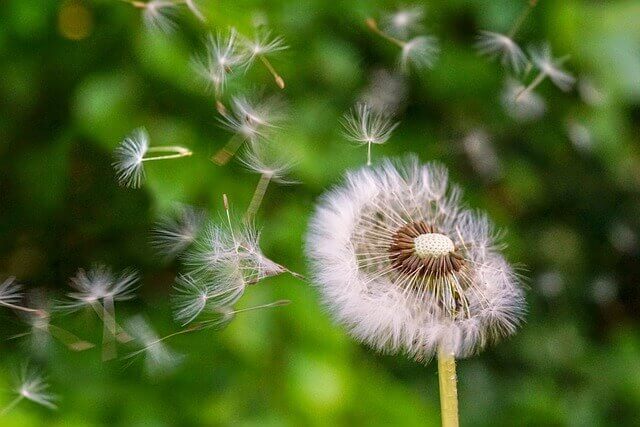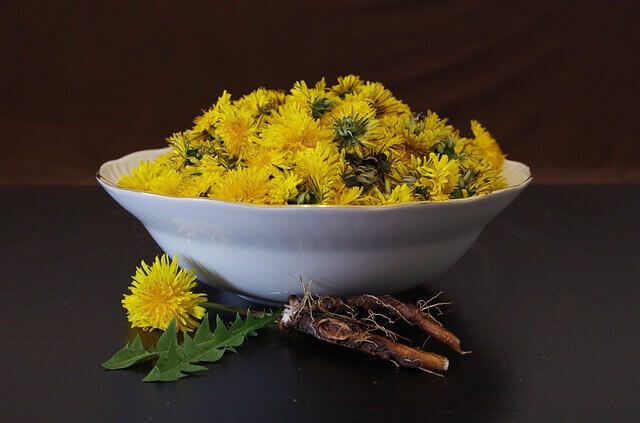53 Fun Facts About Dandelions (with Photos & Information)

Dandelion is a plant that many people either love or hate. This article will explore the 53 fun facts about dandelions, as well as provide photos and growing info to help you decide if this plant should be grown in your garden.
Table of Contents
Overview
- Order: Asterales
- Family: Asteraceae
- Genus: Taraxacum
- Sub Family: Cichorioideae
- Tribe: Cichorieae
- Scientific Name: Taraxacum
- Plant Type: Weedy perennial herb.
- Flower Color: Yellow flowers.
- Propagation: Seeds.
- Plant Height: 8-18″ inches.
- Plant Spacing: 4-6″ inches.
- Zones: 3 and 10.
- Blooming Period: May to October.
Plant Description
The Dandelion plant is a perennial flowering herb. It grows in meadows, along roadsides, and any area with well-drained soil. The flowers are yellow and usually have a dark red or brown center. The leaves are deeply indented saw-toothed margins. The Dandelion plant can reach up to three feet in height when standing erect from the ground.
The leaves are long at the base of the stem but become shorter farther up on it, pointing directly upward when standing straight from the ground – making it similar to a lion’s mane when viewed from below.
The flowers are in a single round cluster at the end of the stem. The leaves are very deep-lobed, with toothed edges. The plant is most easily identified in mid-spring, when the distinctive yellow flowers. The Dandelion plant is considered by some to be a weed. However, it is very useful, as it has many uses.
Fun Facts About Dandelion
- Dandelions are found all over the world except Antarctica.
- The first written record of the use of dandelions as food is in 18th century Italy, when people were boiling them into wine or making jelly from their flowers.
- The root of the dandelion is used to treat gallstones and liver disease.
- Dandelions can help relieve stress by releasing serotonin, which makes us feel happy.
- The word “dandelion” comes from the French “dent-de-lion”, which means “tooth of the lion.” This is because of the jagged shape of its leaves.
- Dandelions can grow up to 2 feet tall and live up to 8 years.
- Dandelion seeds can be carried for up to 5 miles with wind. These seeds are dispersed when the wind blows them from their point of origin, and they can easily spread through a lawn in a single day.

- The flowers on dandelions are yellow because they attract bees, who transfer pollen to other plants for reproduction purposes.
- Dandelions live on both continents, and can be found throughout the Northern Hemisphere.
- Dandelion leaves are about three times bigger than their stalks.
- Dandelion roots were used by the Teutonic Knights of Germany as a tasty alternative to carrots for common soldiers.
- Dandelion wine was widely used throughout Europe for medicinal purposes.
- Dandelions were used for medicinal purposes in the past. In the 19th century, it was prescribed for people suffering from respiratory illnesses such as whooping cough and bronchitis.
- The US has the greatest number of dandelions in the world, about 1.5 billion pounds of them.
- Dandelions are considered by some to be weeds, but they are not classified as such in North America.
- Dandelion roots contain a compound called taraxasterol that has been proven to have anti-inflammatory properties.
- When you have dandelions, you may want to cut your lawn less frequently because they are great at holding water, thus keeping you from having to mow as much.
- Dandelions can be hard to get rid of. They are very resilient and can even survive after the top part is burned away.
- Dandelion was originally called Taraxacum officinale or “dock’s herb”. The weed called dock’s herb referred to this plant, which was used medicinally by the Aztecs.
- Dandelion is a herb belongs to the daisy family Asteraceae; from the genus “Taraxacum,” which includes daisies, sunflowers, asters, chrysanthemums, goldenrod, dandelions, coneflowers, lettuce, artichokes, sunflowers, marigolds, zinnias, asters, dahlias, chamomile, thistle, sagebrush, yarrow, tarragon, sage, ragweed, and chicory.
- Common names for Dandelion priest’s crown, Irish daisy, monk’s head, blowball, and lion’s tooth.
- The active properties in the herb help control cholesterol levels in the blood, and reduce weight.
- Dandelion greens are a very high source of vitamin-A.
- The herb is an ideal source of minerals like calcium, potassium, manganese, magnesium, and iron.
- The Dandelion herb is a rich source of vitamin-K.
- Dandelions are historically thought to have been brought to North America by European colonists, who saw them growing wild on their trips back from the Old World.
- Dandelion greens are great in salads and can be cooked like spinach, sautéed like spinach, or even added to soups.
- Though dandelions may look like weeds, they’re actually fairly nutritious. They are rich in vitamin A, B, C, K, calcium, potassium, zinc, iron and beta-carotene.
- The leaves of the dandelion look similar to thistle leaves because they’re both members of the daisy family.
- Dandelions can survive extreme temperatures and can even grow after a fire.
- Dandelion roots were used by Native Americans for medicinal purposes.
- There are more than 200 known species of dandelions.
- A single dandelion plant can produce more than 100-150 seed heads.
- In Shakespeare’s play Romeo and Juliet, it is believed that the “dent-de-lion” is what Juliet refers to as a “love potion.”
- The flower itself turns into a puff ball as it ages, which leads to the nickname “blowball.”
- The fluffy white seeds of a dandelion are sometimes used as a mild hallucinogen in a tea.
- Not all dandelions have yellow flowers. Some have white flowers—but they still have the fluffy white seed balls!
- Dandelion leaves were typically used by Native Americans for medicinal purposes because of their diuretic properties.
- It turns out that dandelions are actually good for the environment. Dandelions help reduce pollution by absorbing excess nitrogen from the soil and then releasing it into the atmosphere in their bloom when they die off after flowering.
How To Grow Dandelion From Seeds
Growing the dandelion from seed is a fascinating and rewarding process. Dandelions are one of the most common weeds found in North America, and they grow just about anywhere with poor soil quality. However, if you can find a few hours to sow some seeds and follow these steps closely, you’ll be rewarded with beautiful flowers that will come back year after year!
Step 1: Choose your location. Dandelions grow best in areas with full sun exposure or partial shade.
Step 2: Gather your materials and supplies. You will need a pot, good soil (like garden soil), water, and dandelion seeds!
Step 3: Fill the pot with soil to approximately 1/3 of the way up from the bottom.
Step 4: Add water to moisten the dirt; then sprinkle some dandelion seeds on top of it. Be sure not to cover them with too much dirt because they need sunlight in order to grow!

Grow Tips
- When it comes to seeds, dandelion are self-seeding annuals. They typically produce many seeds per flower head, and these seeds are easily transported via wind or animals. Once they land in your grass lawn, they will germinate and grow into a new plant. You can also collect the seeds or root pieces that drop off of mature plants to start new plants in your garden or save for the following season, preventing spreading throughout your yard.
- They are fast growing, requiring only about six weeks of warm temperatures in order to produce their first flower. For most climates, they can be grown outdoors all year long with minimal maintenance.
- Dandelions can be grown in soil or in containers. It is not necessary for the soil to be very fertile or rich with nutrients. A bit of compost will help them grow more quickly and also increase your yield per plant if you use seeds that require more time to germinate than others.
- For container gardening, you may need to adjust the watering schedule, as the watering schedule will be different for container plants. Watering your dandelions more often will allow them to grow more quickly and also prevent any overgrowth from forming in their root zone.
- Plant your seeds after the last frost of spring has passed.
- Give them plenty of water, but don’t overwater.
- Keep an eye on their size to make sure they’re not taking over your garden.
- Harvest when flowers bloom.
- Plant the dandelion seeds in the soil, leaving about 3 inches between each seedling.
- Give them plenty of sun and water regularly, so they don’t dry out.









